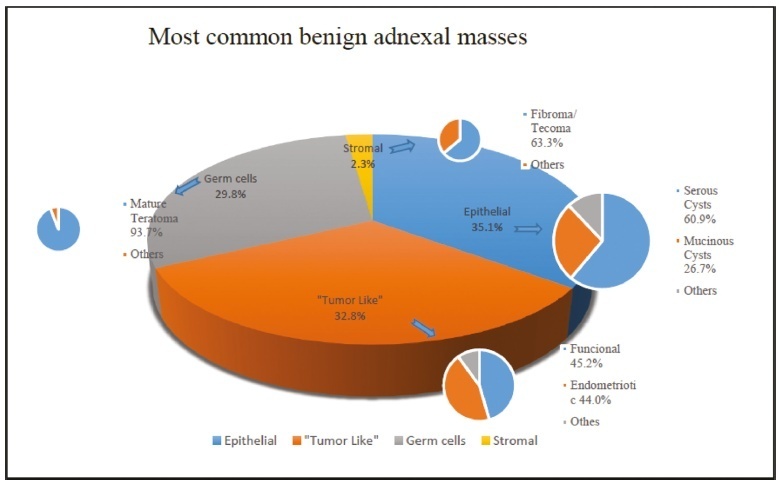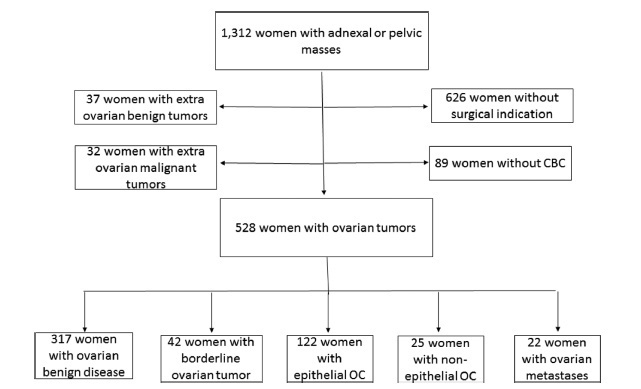Summary
Revista Brasileira de Ginecologia e Obstetrícia. 2020;42(9):569-576
To performa comprehensive review to provide practical recommendations regarding the diagnosis and treatment of benign adnexal masses, as well as information for appropriate consent, regarding possible loss of the ovarian reserve.
A comprehensive review of the literature was performed to identify the most relevant data about this subject.
In total, 48 studies addressed the necessary aspects of the review, and we described their epidemiology, diagnoses, treatment options with detailed techniques, and perspectives regarding future fertility.
Adnexal masses are extremely common. The application of diagnosis algorithms is mandatory to exclude malignancy. A great number of cases can bemanaged with surveillance. Surgery, when necessary, should be performed with adequate techniques. However, even in the hands of experienced surgeons, there is a significant decrease in ovarian reserves, especially in cases of endometriomas. There is an evident necessity of studies that focus on the long-term impact on fertility.

Summary
Revista Brasileira de Ginecologia e Obstetrícia. 2020;42(7):397-403
To evaluate the diagnostic accuracy of cancer antigen 125 (CA125) and complete blood count (CBC) parameters, such as the neutrophil to lymphocyte ratio (NLR), the platelet to lymphocyte ratio (PLR), and thrombocytosis in patients with ovarian masses.
The present is a retrospective study conducted at a single tertiary hospital from January 2010 to November 2016. We included consecutive women referred due to suspicious adnexal masses. The CBC and CA125 were measured in the serum of 528 women with ovarian masses before surgery or biopsy. We evaluated the diagnostic performance of the NLR, PLR, platelets (PLTs), CA125, and the associations between them. We tested the clinical utility of the CBC parameters and CA125 in the discrimination of ovarian masses through decision curve analysis (DCA).
The best balance between sensitivity and specificity was obtained by the associations of CA125 or PLTs ≥ 350/nL, with 70.14% and 71.66%, CA125 or PLTs ≥ 400/ nL, with 67.30% and 81.79%, CA125 or PLR, with 76.3% and 64.87%, and CA125 or NLR, with 71.09% and 73.89% respectively. In the DCA, no isolated CBC parameter presented a higher clinical utility than CA125 alone.
We showed that no CBC parameter was superior to CA125 in the prediction of the malignancy of ovarian tumors in the preoperative scenario.

Summary
Revista Brasileira de Ginecologia e Obstetrícia. 2001;23(8):535-539
DOI 10.1590/S0100-72032001000800009
Luteomas of pregnancy are ovarian pseudotumors diagnosed by ultrasound, during cesarean section or at postdelivery tubal ligation. Twenty-five per cent of the cases appear around the second half of pregnancy. Usually there are signs of maternal virilization and 50% are detected because female newborns show clitorimegaly and/or labial fusion. The concentrations of androgenic steroids in the maternal blood during pregnancy and in the cord blood at child-birth show significantly increased rates. The ultrasound shows solid or cystic-solid structures and few weeks after the delivery they decrease and the ovary size returns to normal. The authors report a case of a patient who exhibited virilization signs in two consecutive pregnancies as well as in the two female fetuses. At adnexal sonographic examination a solid tumoral image was found in both pregnancies. Serum androgen levels were increased.
